
Baghdad: The Great Mosque of Al Nuri, one of Iraq’s most iconic landmarks, reopened in Mosul’s Old City on Monday, September 1, eight years after it was destroyed by ISIS militants.
The mosque, famous for its leaning al-Hadba minaret, was reconstructed under a USD 50 million heritage project led by UNESCO and funded by the United Arab Emirates (UAE).
The “Revive the Spirit of Mosul” initiative not only restored the al-Nuri Mosque but also rebuilt the war-damaged Al-Tahera and Al-Sa’a churches, along with several traditional homes in the historic quarters of the city. The reconstruction aims to preserve Mosul’s cultural identity and symbolises hope for coexistence among its diverse communities.
Prime Minister Mohammed Shia al-Sudani inaugurated the mosque during an official ceremony attended by representatives from the UAE, UNESCO, the European Union, the United Nations, and community leaders from Nineveh Governorate.
He emphasised that the destruction of the mosque and its minaret in 2017 was an attempt by ISIS to erase Mosul’s history, but Iraqis responded with resilience by safeguarding their heritage.
Built in the 12th century by Nur ad-Din Zangi, the al-Nuri Mosque is considered one of Iraq’s most important religious sites. Its 55-metre al-Hadba minaret stood for more than 850 years and was a defining feature of Mosul’s skyline until it was demolished by ISIS during the final stages of the battle to liberate the city.
The mosque also holds a central place in recent Iraqi history. In 2014, ISIS leader Abu Bakr al-Baghdadi declared the so-called “caliphate” from the mosque’s pulpit, cementing its symbolic importance. Three years later, militants destroyed the structure as Iraqi forces advanced to retake Mosul, leaving behind a scar in the city’s cultural landscape.
Launched in 2018, the Mosul restoration project involved clearing rubble, salvaging original materials and removing unexploded ordnance, including a bomb discovered beneath the dome.
The reopening is seen as a milestone in Iraq’s recovery and a powerful symbol of resilience for the people of Mosul.
Editor’s note: This article has been updated for clarity.


